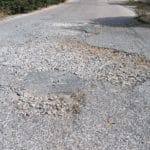If you follow Torrevieja town hall on social media, you will not have missed any of the pre-election activity about how the town is being improved, “we are replacing road signs”, “we are painting the road markings”, “we are renewing pavements”, “we are tending to the gardens”, etc, but the stark reality is, once you cross the border of the N-332 and leave the urban centre, entering into the surrounding urbanisations, a very different picture is painted, a picture that highlights decades of neglect.
The residents of the Torretas urbanisation, which borders on the natural park which plays host to the lagoons, built in the 1980’s, and of course the derelict health spa that cost millions to build, have been wating decades for their infrastructure to be repaired. Last week, they were given a dim light at the end of their very dark tunnel, as a “project” was announced by the town hall to look at the problems of the infrastructure.
It should be pointed out however that a project is nothing more than a costly exercise to look at if or what improvements can be made, and, although it is the first step, is a long way from actually getting results. The project itself costs thousands, usually, but the work identified can run into millions.
Another project announced by the mayor, Eduardo Dolón, is for the creation of a new green area in the Sector 25 urbanisation, although, as if to prove the point of that invisible border, only on the coastal side of the N-332.
However, if we continue along the CV-905, we come to Jardin Del Mar, built in the late 1990’s. an area prone to flooding, where the residents live in fear of the next rainfall, and although there has been activity in recent years to divert the water when it lands, nothing has succeeded, which highlights the problems of building on unsuitable land.
La Hoya offers open fields beyond Jardin Del Mar, where plans have now been approved to build more properties. This will put an undoubtable strain on the infrastructure, and although it will be an improvement on the large amount of industrial waste that is currently found on there, this too is an area prone to flooding, something which will no doubt not be declared to the innocent buyers who choose to purchase those new properties.
But then, that raises the question as to whether anybody would buy them. With the population declining in Torrevieja, although boosted recently by the temporary influx of Ukrainians, there are thousands of properties already vacant and for sale, with other municipalities seemingly more attractive.
That unattractiveness is perhaps highlighted by out next urbanisation on our tour, La Siesta, and El Chaparral, which date back to before the two we have mentioned to the mid 1970’s, and now showing those signs of neglect quite profoundly.
Much of the degradation in La Siesta has been blamed on the residents by the mayor, Eduardo Dolón. “The duty of conservation of the common private spaces of the urbanisations is of the owners of the houses”, was the response of the town hall last year when the Ombudsman got involved, and whereas there is the defence that rubbish is placed by the people, and there are a network of private roads, there are also those under public, or town hall, management, and moreover, the town hall has a duty to ensure compliance.
As the Councillor for International Residents pointed out recently, these areas are where most of the British residents live, a population which has declined the most in recent years, but who would buy a property in an area where there are pavements you can’t walk down, roads that are undrivable, rubbish piled in the streets, overgrown trees blocking paths and even road signs, abandoned vehicles (a common complaint that the urbanisation residents have is they never see police patrols), in other words, all of the things the town hall is laying praise on itself for repairing, but not when you come to those urbanisations beyond that imaginary border, and which were once rich with the international population. Of course, La Siesta will soon be home to the “largest Pump Track in the world”, which might be something to boast about in an ego-stroking way, but how about fixing the infrastructure first.
The matter of waste collection also needs a point of its own, as the new contract, which costs 2 million euro a month, was also celebrated by the town hall, but on these urbanisations the service has not been improved, rather the opposite. The town hall promised an awareness campaign, with leaflets being produced, but those leaflets seemingly didn’t reach beyond the town centre. Now, the urbanisations have larger dustbins, but fewer of them, which means that the majority of residents, many of whom are elderly, now have to walk further to reach their bins, which has already resulted in more rubbish in the streets and the problems that can cause.
And whereas Eduardo Dolón is furthering his own political career, the attention given to Torrevieja may well further decline, and the obsession with paying public money on parties and celebrations might make those in power feel that they are promoting the town, who realistically is going to invest when it is laying in such as state and that money could be otherwise spent improving the living conditions as has happened in other municipalities not so obsessed with wasting public money.
The post The Great Abandonment of Torrevieja Urbanisations appeared first on The Leader – News, Sport, Spanish Property for Sale, Business Directory, Classifieds, and Advertising for Spain.
The post The Great Abandonment of Torrevieja Urbanisations first appeared on Spanishvida – Spanish news in English.

